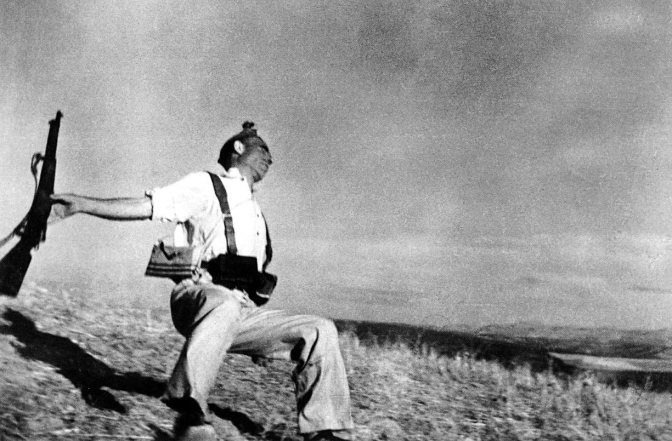The Falling Soldier (also known as Death of a Loyalist Soldier, or Loyalist Militiaman at the Moment of Death) is the greatest war photograph ever taken, and still has the mesmerising power to shock with its stark brutality.
It was taken on September 5, 1936 by Robert Capa, during the Spanish Civil War, and shows the moment a bullet hits a revolutionary soldier’s head, as he falls to the ground, rifle slipping from his hand. Robert was in a trench with 20 militiamen under fire, holding his camera above his head to take pictures up the hill. He was not looking through the camera lens when he clicked the shutter, so could not frame the shot, or gauge the moment of action. It is therefore a fluke moment, as lucky for the photographer as it was unlucky for the freedom fighter whose tragic death was caught on film. Its artlessness imbues it with the power of truth.
Robert was born Andre Friedmann in Hungary in 1913, and fled the rise of Nazism to Paris, where he changed his name and became a photojournalist, specialising in war reportage. He was the only photographer to land with the first wave on Omaha Beach on D-Day, and was awarded the Medal of Freedom by President Eisenhower in 1947 for his unstinting documentation of the war.
Also in 1947, he co-founded Magnum Photos with equally legendary artist Henri Cartier-Bresson as a co-operative agency for freelance photographers, and travelled extensively, repeatedly risking his life to inform the world. He took a compassionate view towards the people he documented, they were frequently experiencing the worst moments in their lives, even potentially near the end, and Robert flirted and joked with them in an effort to cheer them up even briefly. Even something as simple as taking a photograph was just “to let them know somebody cared”.
Doubts have been cast as to the authenticity of The Falling Soldier, as many photos were staged during the Civil War for propaganda purposes. When a box of his negatives was unearthed in Mexico the fact there was not one of his most famous picture seemed to give weight to the nay-sayers, although there is no real evidence to disbelieve Robert’s account of events, only scepticism that such a shot was possible.
Unlike his critics, Robert lived his life with tremendous integrity, recording the horror of war with courageous honesty, right up to his moment of death, stepping on a landmine in Vietnam in 1954. He was just 41 years old, but the intensity of those years showed a depth of knowledge, experience and sincerity. His work is the art of life, frequently at its most extreme and terrifying, the resulting prints a window onto the horror human beings can inflict upon themselves, as well as those moments of humanity inbetween.


